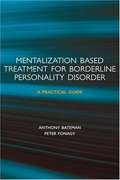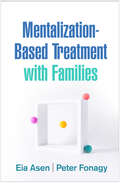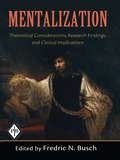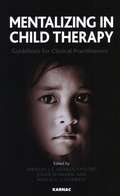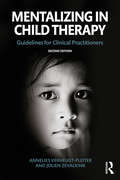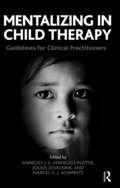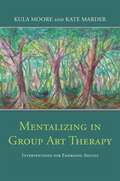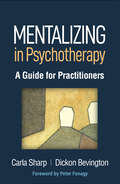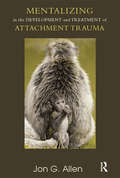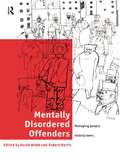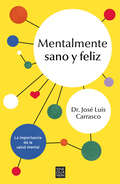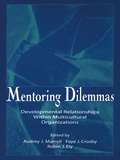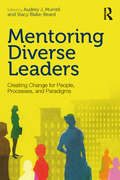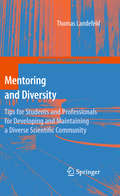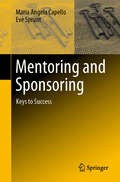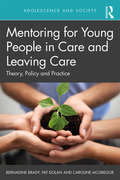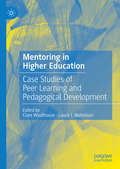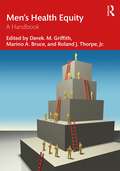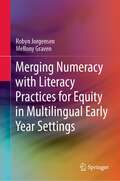- Table View
- List View
Mentalization-Based Treatment for Borderline Personality Disorder: A Practical Guide, First Edition
by Peter Fonagy Anthony W. BatemanMentalization-based treatment for borderline personality disorder is a 'How to Do It' book outlining a clinically proven treatment for Borderline Personality Disorder. Containing illustrative clinical examples, it details precisely how to develop and implement treatment and is a companion to the highly successful book Psychotherapy for Borderline Personality Disorder - mentalization based treatment. This practical guide explains how to treat borderline patients by helping them develop a more robust mentalizing capacity within the context of an attachment relationship. It provides the practitioner with everything they need to know about how to practice mentalizing treatment in day patient and out-patient settings. Enough theory is provided to orientate the clinician and there is step-by-step practical advice on the assessment of mentalizing and interpersonal relationships, how to structure treatment, the use of basic mentalizing interventions and how to apply them, as well as information on what not to do. In addition, it includes a check list to be used in the assessment of mentalizing and a self-rating exercise for practitioners to evaluate their adherence to mentalizing.
Mentalization-Based Treatment with Families
by Peter Fonagy Eia AsenExamining clinical practice with families through a mentalizing lens, this innovative book is filled with practical therapeutic strategies and in-depth case illustrations. The expert authors focus on ways to help parents, children, and adolescents to overcome blocks in how they relate to one another by gaining a deeper understanding of--and openness to--each other's experiences and points of view. The volume draws on the empirically supported mentalization-based treatment (MBT) model and interweaves it with systemic concepts and interventions. It includes guidance for setting up sessions and engaging clients; addressing emotional and behavioral difficulties that frequently lead families to seek treatment; and implementing playful activities, exercises, and games that equip family members to change problematic relationship patterns.
Mentalization: Theoretical Considerations, Research Findings, and Clinical Implications (Psychoanalytic Inquiry Book Series #Vol. 29)
by Fredric N. BuschMentalization is the capacity to perceive and interpret behavior in terms of intentional mental states, to imagine what others are thinking and feeling, and is a concept that has taken the psychological and psychoanalytic worlds by storm. This collection of papers, carefully edited by Fredric Busch, clarifies its import as an essential perspective for understanding the human psyche and interpersonal relationships. The book is divided into theoretical, research and clinical papers, reflecting how the investigators thoughtfully and purposefully pursued each of these goals. Those involved in identifying mentalization have also made consistent efforts to measure and research the concept. Thus, in addition to expanding the theoretical bases and implications of mentalization and identifying clinically useful applications, the authors describe research that scientifically grounds the concept. Mentalization addresses and expands upon a number of implications of mentalization. These include: What are the broader implications for mentalization with regard to social and evolutionary development? How does mentalization interdigitate with other psychoanalytic models? How is mentalization systematically assessed? What clinical correlates have been found? How do we understand variations in the capacity for mentalization, even within a given individual? What are the applications of mentalization in the clinical arena, including specific disorders? Readers of this volume will find their clinical work to be more productive and their view of the human psyche broadened.
Mentalizing In the Development and Treatment of Attachment Trauma
by Jon G. AllenThis book brings together the latest knowledge from attachment research and neuroscience to provide a new approach to treating trauma for therapists from different professional disciplines and diverse theoretical backgrounds. The book is not only an essential resource for psychotherapists and counselors but also an ideal guide to give to clients to help them understand their condition and the process of healing.
Mentalizing Power and Powerlessness: Constructive and Destructive Use of Power in Psychotherapy
by Marie-Luise AlthoffIn this book, the author discusses with a view to psychotherapeutic practice how power and the exercise of power can be used in a constructive sense. Spontaneously, people tend to associate the topic of power negatively. They mostly talk about their own powerlessness and the power of "those up there", and very rarely about their own striving for power. It is undisputed that power and the exercise of power, as well as dealing with powerlessness, play an important role in psychotherapy. Nevertheless, the constructive and destructive aspects of power are still too little reflected. Here, there is a mentalization deficit on the part of both psychotherapists and patients. In this book questions are asked and suggestions for practice are developed. Written for psychological psychotherapists, child and adolescent psychotherapists, family therapists, counselors, psychiatrists, physicians, students, and psychotherapists in training.
Mentalizing in Arts Therapies
by Marianne VerfailleThis book describes the use of therapeutic art, music, and dance interventions against a background of mentalization, thus forging a link between arts therapies and mentalization-based treatment. This book has its roots in the theory of Mentalization Based Treatment by Antony Bateman and Peter Fonagy, and combines the broad experience of many art therapists with art, music and dance/movement therapy in psychiatric settings in the treatment of adults and adolescents both individually and in groups, as well as children with disorganised attachment. As a treatment concept, mentalization is quite straightforward because mentalizing is a typically human ability. As Bateman and Fonagy (2012) say: "Without mentalizing there can be no robust sense of self, no constructive social interaction, no mutuality in relationships, and no sense of personal security". On the other hand, it is not so simple to fully grasp the significance of mentalization. Mentalization-based therapy is a specific type of psychotherapy designed to help people reflect on their own thoughts and feelings and differentiate them from the perspectives of others.
Mentalizing in Child Therapy: Guidelines for Clinical Practitioners
by Jolien Zevalkink M. G. L. Schmeets Annelies J. E. Verheugt-Pleiter J. E. Verheugt-PleiterPsychoanalysis has always been a developing field. For the treatment of children whose development has come to a standstill, mentalization-based child therapy-previously known as developmental therapy-is the latest branch on this tree of knowledge. A combination of data from psychoanalysis, infant research, attachment research and neurobiology was of decisive significance in reaching this point. It is becoming clear that neurobiological processes can very well be understood on the basis of psychoanalytic frameworks. These new insights into people's mental functioning also serve to foster collaboration, resulting in an integration of the more relationship-oriented treatments and the more competence-oriented treatments. This book will fill a growing need in mental health care for children and young people: integrated treatment, that is, using several different modes of treatment at the same time when the problems are complex. Treating complex problems in children with new psychoanalytic techniques is expected to add a new dimension to the practice of treatment, one that is interesting to cognitive behavioral therapists and psychoanalytically schooled psychotherapists alike. One step further, mental health care for children and adolescents may well draw benefits from the achievements of psychoanalysis, thus embedding psychoanalysis more firmly in the field of mental health care. To achieve this, not only will the various forms of psychotherapy need to be integrated, but the therapists as well.
Mentalizing in Child Therapy: Guidelines for Clinical Practitioners
by Jolien Zevalkink Annelies Verheugt-PleiterMentalizing in Child Therapy focuses on open-ended psychotherapy for children with complex mental health issues and attachment problems. It offers examples of personalized and integrated treatment that is "firm in structure yet flexible in its focus" (Peter Fonagy, foreword to first edition). The book is based on the systematic observation of the treatment of complex problems in children (4-12 years) using a mentalizing therapeutic stance and a range of techniques to enhance mentalizing abilities and trust in other people, incorporating aspects of the more relationship-oriented and competence-oriented treatments. In this updated edition, the authors have elaborated on the topic of attention regulation, having included Siegel’s concept of the ‘window of tolerance’. They’ve also written more on the mentalizing abilities of the therapist, the importance of providing structure at the beginning of the treatment, and the value of communication for developing epistemic trust. Featuring guidelines for clinical practitioners, this book is important for the clinical training of child psychotherapists, as well as for professional child psychiatrists, child psychologists and other therapists working with four to 12-year-old children experiencing significant developmental problems with mentalizing.
Mentalizing in Child Therapy: Guidelines for Clinical Practitioners (The\developments In Psychoanalysis Ser.)
by Jolien Zevalkink Annelies J. E. Verheugt-Pleiter Marcel G. J. SchmeetsMentalization-based child therapy, previously known as developmental therapy, is the latest branch on the psychoanalytic tree of knowledge. It comprises a number of techniques that address deficiencies in specific areas of psychological development. It aims to treat children whose development has come to a standstill. A combination of data from psychoanalysis, infant research, attachment research, and neurobiology was of decisive significance in reaching this point. It is becoming clear that neurobiological processes can be understood very well on the basis of psychoanalytic frameworks. These new insights into peoples mental functioning also serve to foster collaboration, resulting in an integration of the more relationship-oriented and the more competence oriented treatments. This book aims to fill a growing need in mental health care for children and young people to recieve an integrated treatment.
Mentalizing in Group Art Therapy: Interventions for Emerging Adults
by Kula Moore Kate MarderBy creating a therapeutic outlet for processing and self-expression, art therapy is an especially effective way to help emerging adults to develop their mentalizing faculty. With an 8-week syllabus, this professional guide provides detailed directives on putting mentalizing-based arts interventions into clinical practice with those aged 18-30, in a group or individual setting. With a specific focus on the differences in treating this age group, and case examples to demonstrate how art therapy interventions enhance mentalizing, this guide is an ideal resource for all professional art therapists looking to utilize their distinct capabilities and specialized training in a psychiatric hospital setting.
Mentalizing in Psychodynamic and Psychoanalytic Psychotherapy: Basics, Applications, Case Studies
by Svenja Taubner Josef Brockmann Holger KirschMentalizing in Psychodynamic and Psychoanalytic Psychotherapy explains how mentalization-based therapy (MBT) can be used within the framework of psychodynamic and psychoanalytic psychotherapies.Josef Brockmann, Holger Kirsch, and Svenja Taubner explain the outstanding importance of mentalizing for contemporary psychoanalysis and assess the essential conceptual innovations of mentalizing, focusing on outpatient individual therapies for patients with personality disorders. The book demonstrates the high connectivity of mentalizing to psychoanalysis and considers the further development of the concept of mentalizing. A practical and research-oriented work, the book documents numerous case studies, and detailed transcripts of treatment dialogs supplemented by extensive commentary to illustrate the practical application of mentalizing.Mentalizing in Psychodynamic and Psychoanalytic Psychotherapy will be of great interest to psychoanalysts and psychoanalytic psychotherapists in training and in practice who are looking to integrate mentalizing into their work.
Mentalizing in Psychotherapy: A Guide for Practitioners (Psychoanalysis and Psychological Science)
by Dickon Bevington Carla SharpHow can therapists help clients reflect more deeply on their own--and other people's--thoughts and emotions? How can the therapeutic relationship be leveraged effectively to create change? This concise book guides therapists of any orientation to incorporate innovative mentalization-based strategies into assessment and intervention. Complex ideas are clearly explained and illustrated with extensive session transcripts and vignettes. Ways to help clients struggling with dysregulated emotions and behavior are highlighted. Compelling topics include the role of mentalization difficulties in personality disorders, special concerns in working with adolescents, and how clinicians can improve their own mentalizing capacities.
Mentalizing in the Development and Treatment of Attachment Trauma: Mentalizing In The Development And Treatment Of Attachment Trauma (The\developments In Psychoanalysis Ser.)
by Jon G. AllenThis book brings together the latest knowledge from attachment research and neuroscience to provide a new approach to treating trauma for therapists from different professional disciplines and diverse theoretical backgrounds. The field of trauma suffers from fragmentation as brands of therapy proliferate in relation to a multiplicity of psychiatric disorders. This fragmentation calls for a fresh clinical approach to treating trauma. Pinpointing at once the problem and potential solution, the author places the experience of being psychologically alone in unbearable emotional states at the heart of trauma in attachment relationships. This trauma results from a failure of mentalizing, that is, empathic attunement to emotional distress. Psychotherapy offers an opportunity for healing by restoring mentalizing, that is, fostering psychological attunement in the context of secure attachment relationships-in the psychotherapy relationship and in other attachment relationships. The book gives a unique overview of common attachment patterns in childhood and adulthood, setting the stage for understanding attachment trauma, which is most conspicuous in maltreatment but also more subtly evident in early and repeated failures of attunement in attachment relationships.
Mentalizing the Body: Integrating Body and Mind in Psychotherapy
by Ulrich Schultz-VenrathMentalizing the Body brings together theory and practice with the latest neurobiological and developmental psychological findings to understand the relevance of the body in a wide range of mental disorders, especially personality and somatization disorders. Ulrich Schultz-Venrath provides insight on individual bodily phenomena within psychotherapeutic treatments – experienced by patients as well as therapists – and focuses on the importance of the intentionality of bodily symptoms and how they can be integrated in the talking cure. Mentalizing the Body expands the work of Anthony Bateman and Peter Fonagy, adding the “body mode” in contrast to the popular concept of “embodied mentalizing.” Promoting mentalizing in psychotherapy while taking the body into account helps not only patients with somatoform and eating disorders, but also those whose psychological complaints have a missing connection to the body. Schultz-Venrath provides detailed insight on the range of therapies and treatments available, from individual and group psychotherapies to body, art, and music therapy, with clinical case studies and diagrams throughout. Mentalizing the Body will be of great interest to practitioners and researchers – from psychoanalysts and psychotherapists to psychiatrists and psychologists seeking to understand the mentalization model, and all healthcare professionals working with severe mental disorders.
Mentally Disordered Offenders: Managing People Nobody Owns
by Robert Harris David WebbManaging the Mentally Disordered Offender presses the case for better health care of mentally disturbed law breakers, and the need to divert them from unnecessary imprisonment.Mentally disordered offenders present particular problems in our society, which wants both to sympathise and to punish. How do we get the balance right between sympathy towards their illness and genuine worries about their offending behaviour? What do we do for - and about - people wo have been released from prison yet we suspect continue to pose risks to the safety of others?With specialist contributors from criminology, criminal justice, social work, probation practice and the law, Managing the Mentally Disordered Offender stresses the importance of professional cooperation in community-based services, whilst acknowledgin the psychologically demanding nature of working with mentally disordered people, and ther very real challenges of attempting to contain their wrongdoing without recourse to the repressiveness of imprisonment.
Mentalmente sano y feliz: Mitos y realidades de la salud mental
by José Luis Carrasco Perera¿Qué es la salud mental y de qué manera está ligada a la felicidad? Una de cada cuatro personas sufrirá un trastorno mental a lo largo de su vida. La Organización Mundial de la Salud define la salud mental como un «estado de bienestar psíquico que permite a las personas hacer frente a los momentos de estrés de la vida, desarrollar todas sus habilidades, poder aprender y trabajar adecuadamente y contribuir a la mejora de su comunidad»En este libro, el doctor José Luis Carrasco -referente fundamental de la psiquiatría contemporánea- nos acerca, con un estilo divulgativo, a una de las grandes preocupaciones de la sociedad contemporánea: los trastornos psiquiátricos. El autor aporta, en un lenguaje sencillo, luz y claridad sobre los criterios de salud mental y felicidad, de las emociones, los pensamientos y de las relaciones personales desde el punto de vista médico, social e individual. «La salud mental no se alcanza siguiendo modas ideológicas, es más bien el fruto de unos fenómenos naturales que reducen el malestar y ayudan a tolerar el estrés, estimulando las habilidades mentales y relacionales. La salud mental está ligada a un bienestar más interno que externo y los consejos y las reflexiones contenidas en este libro pueden ayudar a conseguirla».
Mentoring Dilemmas: Developmental Relationships Within Multicultural Organizations (Applied Social Research Series)
by Robin J. Ely Audrey J. Murrell Faye J. CrosbyThe world is continually changing. As organizations become more diverse, the need to recognize and develop talent within others becomes more critical and more complex. Herein lies the fundamental dilemma that parties to these important relationships face. Based on a recent gathering in Amherst, the contributors of this volume attempted to help each other better understand the issues that they were facing in their own diversified mentoring relationships as mentors, protégés, or both. This volume is the result of their efforts. Organized into three sections, the book focuses on the different types of mentoring perspectives--theoretical, empirical, and experiential. It addresses the following issues: *Developmental relationships--the emerging themes and theoretical models that discuss the experiences of various ethnic populations, *Empirical evidence--qualitative and quantitative research that examines the impact of diverse mentoring relationships, *First-hand accounts--experiences that recount key lessons learned in various situations, including breaking the glass ceiling, among others.
Mentoring Diverse Leaders: Creating Change for People, Processes, and Paradigms
by Audrey J. Murrell Stacy Blake-BeardMentoring Diverse Leaders provides up-to-date research on the impact of mentoring relationships in organizations, particularly as they relate to cultivating diverse leadership. Contributions from experts in the fields of psychology, business, law, non-profit management, and engineering draw connections between mentoring research, theory, and practice in both domestic and global organizations. Rather than standing apart from the broader goals and objectives of these organizations, they demonstrate the ways mentoring for diversity actually drives innovation and change, talent management, organizational commitment, and organizational success.
Mentoring and Diversity
by Thomas LandefeldThis book will provide basic guidelines for facilitating the educational advancement of under represented students in the sciences, not only from the student perspective but also from the perspective of faculty advisors/mentors. Although the proper mentoring and advising of students about careers and preparation for the education and training associated with them is one of the most important components of a student's education process, this aspect has been severely lacking in academia in the past as well as the present. This is particularly the case with under represented ethnic minorities, despite the fact that mentoring of minority students has been identified as probably the most effective means for assisting them in achieving success. There are a multitude of reasons for this deficiency, including not enough mentors, students not "reaching out", lack of resources as well as other societal and academic limitations. This book provides tips to help guide a student on choosing mentors, what to expect from mentoring, and effectively developing a strong personal portfolio. Tips are also provided to scientists and faculty on being an effective mentor. The emphasis of the book will be primarily on students of color in the sciences, who are severely under represented, and will be presented in a "guidebook" format to simplify the process as much as possible.
Mentoring and Sponsoring: Keys to Success
by Maria Angela Capello Eve SpruntThis book is a compilation of very personal approaches to mentoring and sponsoring, breaking the stereotypes of seniority, age or experience. The authors have provided a platform to understand that mentoring and especially sponsoring are in fact a win-win relation, in which both sides, mentors and mentees; and sponsors and sponsored individuals learn from each other, enhancing their career paths. How they managed to create a growth space for themselves and their teams through mentoring and sponsoring, is a story of professional leadership. They shared a privileged outlook to understand the root causes of barriers, as well as to envision plausible solutions for difficult career crossroads, in which mentorship or sponsoring was key to steer step changes.The authors propose not only their vision, but a remarkable collection of unfiltered interviews with young and renown professionals in many sectors, from photography to music, research, sports, energy, and more, completing a vision of what is key for both sides of the equation pertinent to mentoring and sponsoring: the givers and the receivers. They explain what is needed to gain the most out of the mentoring and sponsoring loops, with their own career stories.Success is supported by many factors, in which the most important are the technical competency and performance aligned with resilience. However, in the long path of a career, mentors and particularly sponsors play a foundational and frequently a changing-life role, improving our perspective or triggering reflections and actions that benefitted our journeys at work and in life.This book provides insights on what works for an effective mentoring and sponsoring process. It is useful for all professionals, especially those starting their career journeys.
Mentoring for Young People in Care and Leaving Care: Theory, Policy and Practice (Adolescence and Society)
by Pat Dolan Bernadine Brady Caroline McGregorMentoring for Young People in Care and Leaving Care offers a rich exploration of the theory, research and practice relating to youth mentoring as a means of essential social support. Brady, Dolan and McGregor ground their work on the premise that the informal social support provided through a high-quality mentoring relationship can help young people in care to sustain positive mental health, cope with stress and fulfil their potential through adolescence and into adulthood. It provides an up-to-date synthesis of research findings in relation to natural mentoring, formal mentoring and youth-initiated mentoring for children in care and explores the challenges and considerations relating to practice in this area. Illustrated with the details of original research with care-experienced young people, it offers much-needed insight into how young people interpret and make sense of their experiences in care and of mentoring. Written to be accessible by those with limited knowledge of youth mentoring, this timely publication will be essential reading for academics, policy makers and practitioners in the fields of adolescent development, social care, social work and youth work.
Mentoring in Higher Education: Case Studies of Peer Learning and Pedagogical Development
by Clare Woolhouse Laura J. NicholsonThis book explores the role and importance of mentoring as a form of collaborative learning in higher education. While mentoring has become increasingly popular, the definition itself can remain broad and potentially nebulous, and could be applied to a variety of endeavours. The chapters engage with case studies and empirical research from across the globe that respond to concerns raised within a range of cross-disciplinary fields, providing important clarity as to the role of mentoring within higher education. Offering clarity and precision as well as robust qualitative data, this book will be of interest and value to scholars of mentoring in higher education as well as those engaged in mentoring themselves.
Men’s Health Equity: A Handbook
by Marino A. Bruce Derek M. Griffith Roland J. Thorpe Jr.Worldwide, men have more opportunities, privileges, and power, yet they also have shorter life expectancies than women. Why is this? Why are there stark differences in the burden of disease, quality of life, and length of life amongst men, by race, ethnicity, (dis)ability status, sexual orientation, gender identity, rurality, and national context? Why is this a largely unexplored area of research? Men’s Health Equity is the first volume to describe men’s health equity as a field of study that emerged from gaps in and between research on men’s health and health inequities. This handbook provides a comprehensive review of foundations of the field; summarizes the issues unique to different populations; discusses key frameworks for studying and exploring issues that cut across populations in the United States, Australia, Canada, the United Kingdom, Central America, and South America; and offers strategies for improving the health of key population groups and achieving men’s health equity overall. This book systematically explores the underlying causes of these differences, describes the specific challenges faced by particular groups of men, and offers policy and programmatic strategies to improve the health and well-being of men and pursue men’s health equity. Men’s Health Equity will be the first collection to present the state of the science in this field, its progress, its breadth, and its future. This book is an invaluable resource for scholars, researchers, students, and professionals interested in men’s health equity, men’s health, psychology of men’s health, gender studies, public health, and global health.
Meow or Never: A Wish Novel (Wish)
by Jazz TaylorAvery Williams can sing, but that doesn't mean she can sing in front of people. She likes to stay backstage at her new school, which is where, to her surprise, she finds a cat tucked away into a nook. Avery names the stray Phantom and visits any time she's feeling stressed (which is a lot these days).As she sings to Phantom one day, her crush, Nic, overhears her and ropes Avery into auditioning for the school's musical. Despite her nerves, Avery lands the lead role!She knows she should be excited, but mostly Avery is terrified. Can Phantom help her through her stage fright? And what will happen if anyone finds out about her secret pet?
Merging Numeracy with Literacy Practices for Equity in Multilingual Early Year Settings
by Robyn Jorgensen Mellony GravenThis book draws on both in and out of school literacy practices with teachers and families to enhance the numeracy of early learners. It provides highly illustrative exemplars, targeted for learners up to approximately eight years of age whose home language differs from the language of instruction. It identifies the challenges faced by these learners and their families, and shares ways of building both literacy and numeracy skills for some of the vulnerable learners nationally and internationally.The book shares the outcomes and strategies for teaching mathematics to early years learners and highlights the importance of literacy practices for learners for whom the language of instruction is different from their home language. Readers will gain a practical sense of how to create contexts, classrooms and practices to scaffold these learners to build robust understandings of mathematics.
